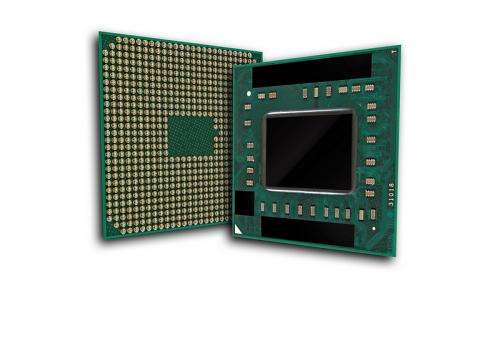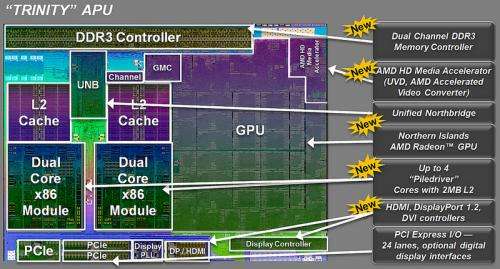May 15, 2012 report
AMD's Trinity is out to rattle Intel's Ivy Bridge

(Phys.org) -- AMD has announced Trinity, its second-generation A-Series accelerated processing units (APUs), which are out to rival Intel’s Ivy Bridge processors. AMD’s Trinity is an update to its Llano, which attempted to challenge Intel’s Sandy Bridge. Trinity includes up to four CPU cores ad single GPU, with features especially suited for supporting laptops and ultra thin notebooks. The Trinity chips will appear on HP’s Sleekbook machines when the Sleekbook debuts next month. With Trinity, AMD is promoting its two appealing strong suits that sit well with manufacturers and consumers, in the name of graphics performance and power consumption.
According to AMD, Trinity has up to 12 hours of battery life, whereas Llano offered 10.5. Once products appear that carry Trinity processors, the real numbers will either comply or will need some adjustments. Besides HP, according to reports, Asus, Lenovo, Samsung, Toshiba, and Acer may announce mobile devices based around Trinity shortly. The battery-life calculations that were announced by AMD are based on the average power on multiple benchmarks and usage scenarios, said the company. Twelve hours of battery life are based on Windows Idle (740 min./12:20 hours) as a resting metric.
Technology strengths in Trinity center on having fine-tuned power management.

A BBC report on the Trinity launch carries comments from AMD’s CTO, Joe Macri, who talked about Trinity’s Piledriver architecture of the CPU cores. He referred to Piledriver's energy-saving technique, which is “resonant clock mesh technology,” where some of the energy consumed while doing calculations is recycled. Further, power savings have been achieved, says AMD, by running more processes on the GPU. The power is dynamically shifted between the CPU and GPU depending on application needs.
Trinity is using AMD Radeon HD 7000 Series graphics for an increase of graphics performance up to 56 percent over the previous generation, claims AMD. Trinity offers HD, 1080p resolution gaming, delivering 30 frames per second. Similarly, the industry standard for smooth gaming is 30 frames per second. While graphics performance features are a marketable strength for gamers, AMD could also benefit from a class of business computer users whose work could use higher-end graphics capabilities, as for high-definition video discussions and trader applications, where multi-screen support and high-speed rendering are important.
AnandTech, in assessing Trinity’s performance, found that, while AMD had a tough job of increasing performance without ballooning die size, the die size went up only by around 7percent and yet AMD achieved “double-digit increases” over Llano in CPU and GPU performance. “If you liked Llano, you'll love Trinity,” said the report.
More information: Press release
© 2012 Phys.Org




















